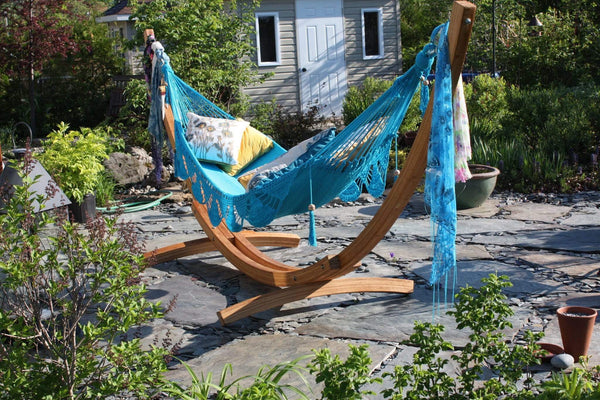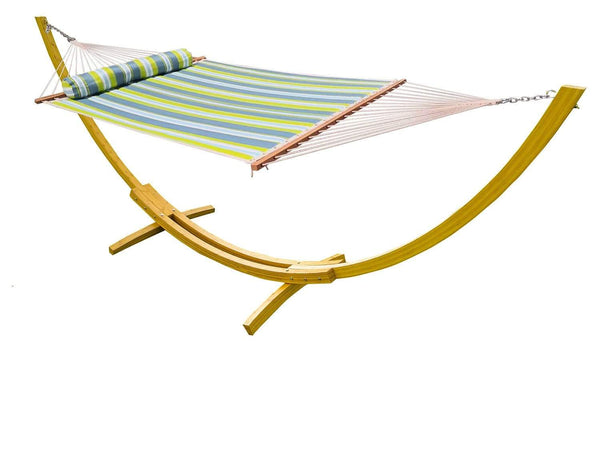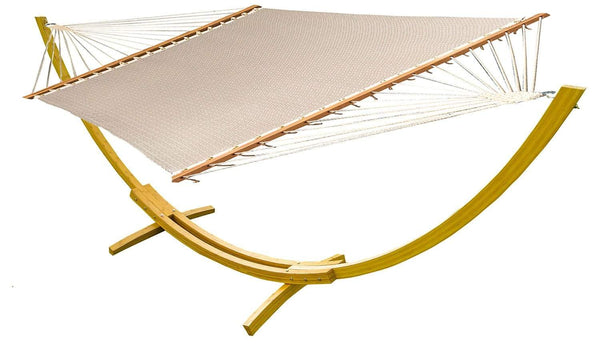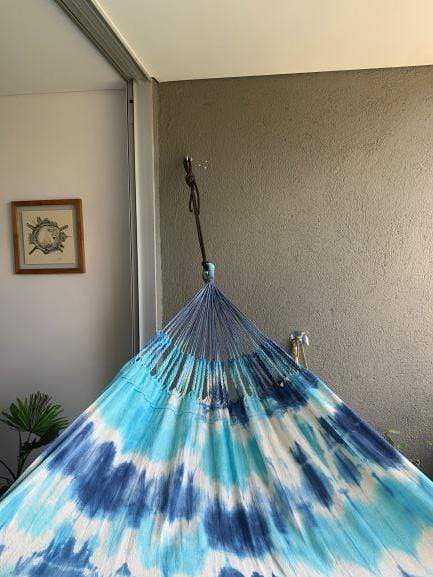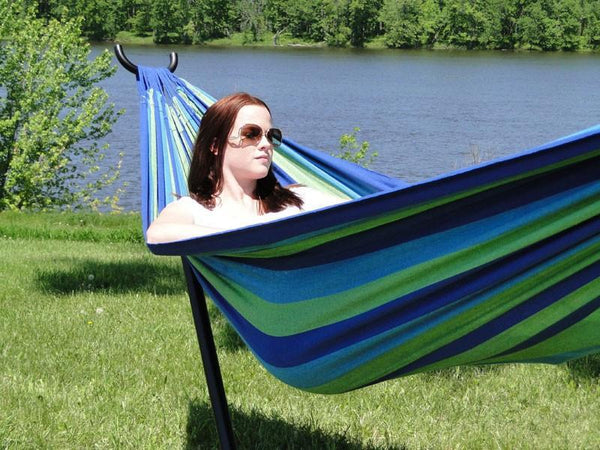FREE SHIPPING on most orders $25+ HAMMOCK BUYING GUIDE
Menu
-
-
Hammocks
-
Hammock Stands
-
Hammocks with Stands
-
Hanging Hammock Chairs
- View all Hammock Chairs
- Brazilian Style Hammock Chairs
- Colombian Hammock Chairs
- Mayan Hammock Chairs
- Mayan Hammock Chairs Deluxe
- Universal Hammock Chair Stand
- U Hammock Chair Stand
- Brazilian Hammock Chair with Universal Chair Stand
- Colombian Hammock Chair with Universal Chair Stand
- Mayan Hammock Chair with Universal Chair Stand
- Mayan Hammock Chair Deluxe with Universal Stand
-
Accessories
- Gift Cards
- Tools and Guides
- Bargain Bin
-
- 1-800-207-4761
- Login

FREE SHIPPING on most orders $25+ HAMMOCK BUYING GUIDE
Hammock Maintenance: Tips for Longevity
September 06, 2024 6 min read

Audio Version
As the vibrant colors of summer give way to the crisp air of fall, it's a good time for to think about caring for our favourite hammocks. Hammocks offer the perfect spot to relax, unwind, and enjoy the great outdoors, so it’s worth investing a little time in maintaining them. Proper care not only extends the life of your hammock but also ensures it remains a comfor and safe place for relaxation.
Maintaining your hammock is easier than you might think. In this guide, we’ll share practical tips on how to clean, store, inspect, and repair your hammock. From routine cleaning to weather-proofing, we've got you covered to keep your hammock in top shape year-round.
Best Practices for Storing Your Hammock
Storing your hammock properly when it’s not in use is crucial for its longevity. The Canadian winter can be particularly harsh, and improper storage can lead to wear and tear that shortens the life of your hammock. To keep it in top shape, store your hammock in a cool, dry place. Avoid areas that are damp or exposed to direct sunlight, as these conditions can cause mildew or fade the colours.
Make sure your hammock is completely dry before you store it. Even a small amount of moisture can lead to mould and mildew. After cleaning your hammock, let it dry thoroughly. Fold it neatly and place it in a storage bag or cover. This protects it from dust, dirt, and pests. If your hammock didn’t come with a storage bag, use any breathable fabric bag. Avoid plastic bags, as they can trap moisture.
Another key point is to store your hammock away from direct heat sources.
While it might be tempting to hang it in the garage or shed, make sure it’s not near heaters or hot water tanks. Heat can weaken the fabric and reduce its lifespan. If you’re storing your hammock indoors, a closet or under the bed can be ideal spots. For those with limited indoor space, consider a weatherproof storage bin for outdoor storage, but make sure it’s placed in a sheltered location.
How to Inspect Your Hammock for Damage
Regular inspections are essential for hammock maintenance. Before you store your hammock for the winter, take a few moments to check it over for any signs of damage. Small issues can become bigger problems if left unaddressed.
Start by examining the fabric or ropes closely. Look for any fraying, tears, or weak spots. These can develop over time from regular use and exposure to the elements. Pay special attention to the areas where the hammock connects to its supports, as these spots can experience more stress and wear. If you find any small frays or tears, consider repairing them now to prevent them from worsening. Always exercise caution when making repairs to structural parts. Be sure to seek professional help if you are not completely confident in your repairs.
Next, check the hammock’s hardware. This includes the hooks, carabiners, and any other metal parts. Look for signs of rust or corrosion, which can weaken the hardware and pose a safety risk. If you find any rusty parts, replace them with new ones. It’s a small investment that can prevent bigger issues down the line.
Finally, give the hammock a gentle stretch and shake. This can help you identify any hidden issues and ensure that all parts are secure. If you notice any unusual noises or movements, inspect the affected area more closely. Sometimes, the issue might be with the suspension system rather than the hammock itself. Check the straps and ropes for signs of wear and replace them if necessary.
Weather-Proofing Your Hammock
Weather conditions can significantly affect the longevity of your hammock, especially in Canada (that needs no explanation, eh?). Preparing your hammock for different weather conditions is essential to keep it in good shape.
Protective covers are a great investment. They shield your hammock from rain and snow, preventing moisture from seeping into the fabric or ropes. As we already mentioned, moisture can lead to mould and mildew, which weaken the material. When not in use, keep your hammock covered, especially during unexpected showers. If your hammock gets wet, make sure it’s completely dry before you store it. This is especially important as the season changes from summer to fall.
Taking your hammock down during extreme weather is another good practice. Strong winds and heavy rain can cause unnecessary wear and tear. Even if your hammock is made from durable materials, constant exposure to harsh weather can reduce its lifespan. If you know a storm is coming, it’s best to take your hammock down and store it safely. This might seem like extra work, but it can save you money and hassle in the long run.
Seasonal storage is also crucial. As winter approaches, and you know you won't be using your hammock until spring, it’s time to think about putting your hammock away for the season.
Before storing it, clean it thoroughly and let it dry completely. Fold it neatly and place it in a breathable storage bag. Avoid storing it in places that are damp or exposed to direct sunlight. Proper storage during the off-season will ensure your hammock is ready for use when the warm weather returns.
Maintaining Hammock Accessories
Your hammock isn’t the only thing that needs care; the accessories also require regular maintenance. Straps, hooks, and stands all play a vital role in your hammock’s setup and should be kept in good condition. After a season of use, it’s important to check these accessories to ensure they’re still safe and functional.
Start with the straps. Over time, they can become worn and frayed, especially if they’ve been exposed to the elements. Inspect them closely for any signs of damage. Clean them with mild soap and water to remove dirt and grime. If the straps show significant wear or damage, it’s best to replace them. This ensures your hammock remains secure and safe.
Hooks and carabiners are next on the list. These metal parts can rust or corrode, particularly if they’ve been exposed to moisture. Check them for any signs of rust and clean them with a gentle brush. If the rust is extensive, replace the hooks or carabiners. Using rusted hardware can compromise the safety of your hammock setup.
Hammock stands also need attention. Inspect the stand for any signs of rust or structural damage. Clean it thoroughly, removing any dirt or rust. If the stand has moving parts, like bolts or screws, check to make sure they’re tight and secure. Lubricate any moving parts to ensure they function smoothly. If you find any significant damage, consider replacing the stand.
Maintaining your hammock accessories is as important as maintaining the hammock itself. Regular cleaning and inspection can prevent accidents and prolong the life of your setup.
DIY Hammock Repairs
Taking care of minor repairs on your hammock can extend its life and keep it safe for use. Small issues like tears or frayed ropes might seem insignificant at first, but they can worsen over time if left unaddressed. Tackling these problems early helps maintain the hammock's integrity and ensures you get the most out of your investment.
For minor tears in fabric hammocks, a simple patch can do the trick.
You'll need a fabric patch kit, which is easily available at most outdoor or hardware stores. Start by cleaning the area around the tear to remove any dirt or debris. Cut a piece of the patch material slightly larger than the tear and apply it according to the kit’s instructions. Usually, this involves placing the patch over the tear and pressing firmly to ensure it adheres well. Let it set for the recommended time before using the hammock again. This quick fix can prevent a small tear from becoming a large hole.
Frayed ropes can be repaired using a technique called whipping. This involves wrapping a strong, thin cord tightly around the frayed area to secure the fibres.
Start by cutting a piece of whipping cord about 60 cm long. Lay one end of the cord along the length of the rope and begin wrapping the rest of the cord tightly around the frayed. Keep the wraps close together, covering the entire frayed area. When you reach the end, tuck the end of the whipping cord under the wraps to secure it. This method strengthens the rope and stops further fraying, ensuring your hammock remains safe to use.
For metal parts like hooks and carabiners, rust can be a common issue. Light rust can often be removed with a wire brush or sandpaper. Gently scrub the rusted area until the metal is clean. For more stubborn rust, a rust remover solution can be used. Apply the solution according to the product instructions, then rinse and dry the metal thoroughly.
If the rust has caused significant damage, it's best to replace the affected parts to maintain safety.
Always exercise caution when making repairs to structural parts. Be sure to seek professional help if you are not completely confident in your repairs.
Keeping Your Hammock in Top Shape
Proper hammock maintenance is essential for enjoying your outdoor relaxation spot year after year. Regular cleaning, proper storage, and addressing minor issues promptly all contribute to the longevity of your hammock.
By taking the time to care for your hammock and its accessories, you're ensuring that it remains a safe and comfortable retreat, ready for use whenever you need a moment of rest. And if you decide to treat yourself to a new hammock, you know where to find it.
Safety First!
When using a hammock*, safety is paramount. Please make sure to follow these important guidelines when purchasing, installing and using a hammock
*(includes Hammock, Hammock Chair, Hammock Stand and Hammock Accessories)
Safety First!
When using a hammock*, safety is paramount. Please make sure to follow these important guidelines when purchasing, installing and using a hammock
*(includes Hammock, Hammock Chair, Hammock Stand and Hammock Accessories)
Related Products
Want to relax?
Join for exclusive content and promotions we only give to our email list!




